February 5, 2020
 |
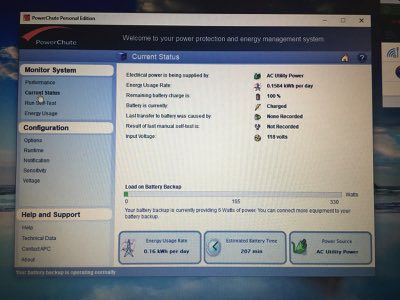 |
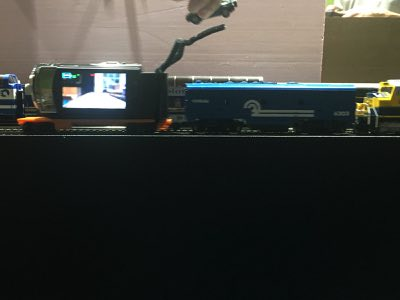 |
| To protect sensitive electronics on the layout from voltage spikes as well as fluctuating voltage I purchased an uninterruptible power supply (UPS). Tonight, after unboxing and installing the UPS Rick plugs both RailPro power supplies into it. |
Rick connects his laptop to the UPS and finds the power draw from the entire RailPro system plus one locomotive is very minimal. He estimates we could run a locomotive for three hours during a power outage. |
My apologies for the poor quality photo. Paul the Painter places his camcorder on a flat car at the front of a Conrail B-unit and Alaska Railroad SD70MAC and runs it around the layout for a unique operations view. Stay tuned for future video clips. |
 |
 |
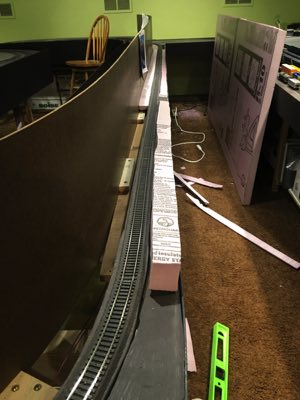 |
| LJ takes the foam board Rick cut last week for TwentyMile and prepares the underside for mounting to the L-girder structure. He creates quite a mess on the floor for the janitor to clean up tomorrow, |
The foam board between the North Pole Refinery and TwentyMile is now in place. |
LJ continues working the foam board through the TwentyMile section. |
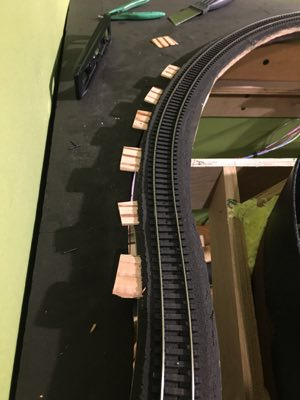 |
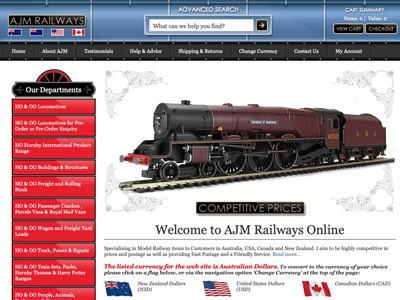 |
|
| Running two SD70MACs end-to-end through the dreaded "S" curve causes the lead unit to derail. After studying the dynamics closely Rick discovers the outer rail is canted down. After applying custom shims to the outer rail the derailments cease. |
The "Rockies" wall backdrop was ordered through AJM Railways in Australia and delivery is expected soon. Brother-in-law Ted is creating a routed wooden ledge to hold the bottom of the foam board mounted backdrops while a joist mounted clip system will hold the top. |
|
February 19, 2020
|
|
|
| Paul the Painter was on hand tonight and plenty of foam board was on hand for him to paint. Three dogs were on hand as well and they made for some tense moments as they walked continually past the freshly painted material. At one point LJ's large white dog Zeus made a casual pass and his long tail became a brown furry canvas. |
Rick prides himself on cutting the foam board for a near perfect fit in the L-girder structure. This particular piece will become the hill transition following Flint Hills Refinery. |
Synchronized foam cutting: As soon as Rick finishes a cut LJ borrows the hot wire cutter to carve a foam piece for the other side of the scenery divider. The two swap the cutter back and forth with nary a second of down time. |
|
|
 |
| All 42 switches are controlled wirelessly from the handheld controller (HC). This is a very powerful feature, but has one drawback. Each switch machine is associated with one of the 11 AM-1s (Accessory Module) positioned through the room. The HC lists the switches by AM-1 numbered groupings so the user must remember the crispens between the two. John spent 3 hours this week printing, cutting and positioning the AM-1 numbers for each switch. These will be pulled once placards are made for the front of the fascias. |
Painted foam board is now in position at TwentyMile. |
The beginning "wedding cake" layers for the transition from Flint Hills Refinery. |
|
|
|
| All painted foam board in place at Alaska Marine Lines. (looking north) |
Most of the painted foam board is now in place at the double track. (looking north) |
Most of the painted foam board is now in place at the double track. (looking south) |
|
|
 |
| Over time part of the fascia on the swing gate came loose. The Liquid Nails and re-clamping effort left white glue lines. The area was masked off using painter's tape and Paul the Painter made it look like new again. |
Rick takes the previously placed shims and trims them them accordingly. Dabs of white glue will hold them permanently in place. This effort will prevent future double headed SD70MAC derailments. |
Music makes for lighter work. Over the past two years the crew's ears were tormented by one of the speakers dropping in and out sporadically. Tonight John put a new receiver into play and Rick moves the equipment to the top of the small refrigerator. Hopefully, this will fix the problem and put to rest the Ghost of Music Problems Past. |
February 26, 2020
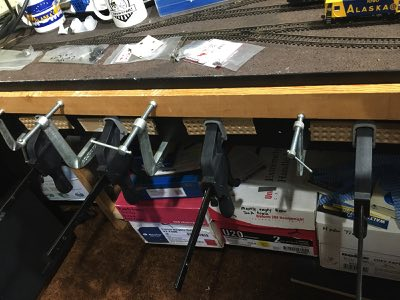 |
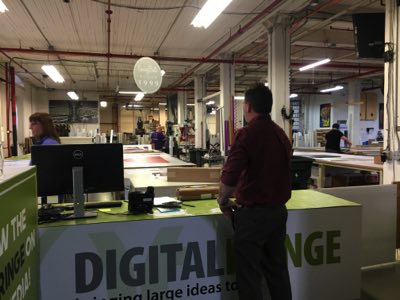 |
 |
| Surprise! For some unknown reason the fascia on the inside of the southern Anchorage yard came unglued. John pulled the fascia back, applied way too much Liquid Nails and clamped everything in place. The clamps were removed on train night and everything held solid. We are hoping not to see a repeat of this elsewhere on the layout in the future. |
John and brother-in-law Ted dropped the mountain backdrops off at Digital Fringe for foam board mounting. These should be ready for pick up before the next train night. An unexpected bonus was being greeted by the owner's three friendly dogs. |
Many moons ago John excitedly ran his first passenger train consist. The vestibules at the end of each car hit, a major derailment ensued and rail cars fell to the floor. Someone suggested long shanked couplers be procured and John purchased two sets. These couplers fit well on the classic ARR passenger cars, but were too thick for the tour company cars. Rick filed the shanks until they operated flawlessly. |
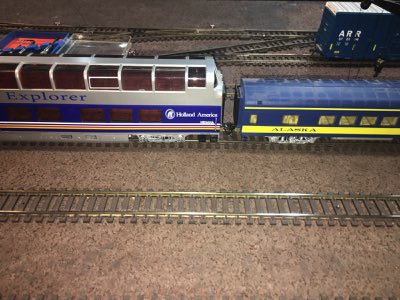 |
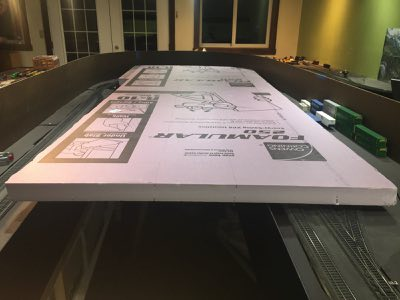 |
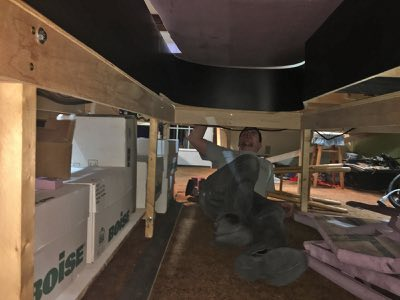 |
| Although the long shank couplers do not appear prototypical they turn out to be an elegant solution. No car modifications need to be made and the cars easily clear the tightest radius on the layout. Eight more pairs will now be ordered. |
LJ lays a large piece of foam board over the open area between Alaska Marine Lines and the double track. |
Crawling under the foam board LJ gets into position and then traces the lines of the fascia and curved track. |
 |
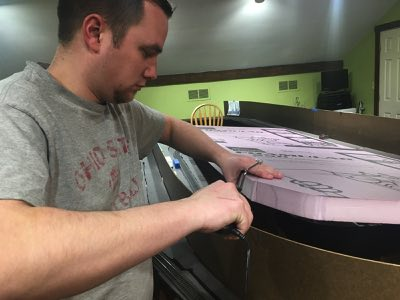 |
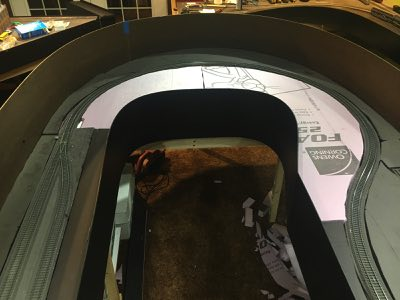 |
| LJ then uses a jigsaw to cut the trace lines. This creates lots of foam "saw dust" which is quickly vacuumed up as winter's dry air causes it to stick to virtually everything. |
A test fit reveals the foam is a big too large. LJ does this by design saying it is better to cut twice then come up short. He uses the hot wire to trim the excess and create a snug fit. |
The end result is a two piece foam board curve. I am so excited as we now have continuous foam board/plywood from the Anchorage yard all the way through Alaska Marine lines. We are getting close! |